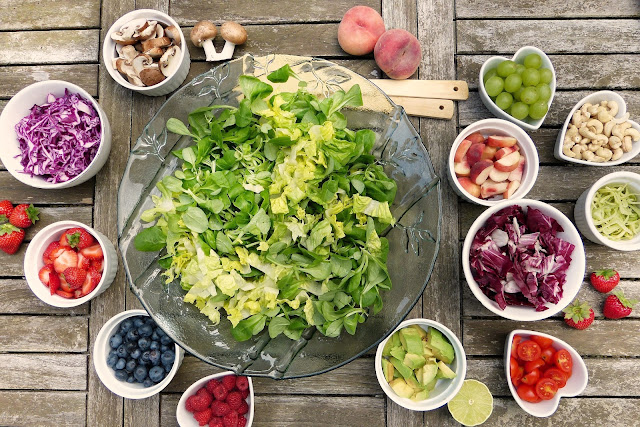Healthy food for a healthy lifestyle –
it’s a no-brainer!
Good nutrition is an important part of leading a healthy lifestyle. The number of calories and nutrients you consume each day can determine your overall health, energy levels, and even the quality of your hair, skin, and nails! If you’re concerned about your own health or the health of your family, pay close attention to this guide on healthy food for a healthy lifestyle—and make sure you read to the end for some bonus tips!
Introduction
A healthy lifestyle is typically defined as one that promotes physical, mental, and social well-being. Healthy lifestyles can range from being active and eating balanced diets to avoiding alcohol and tobacco to living with chronic conditions.
The benefits of a healthy diet are widely documented, but the drawbacks of unhealthy eating habits are not always obvious. Unhealthy dietary patterns have been linked to heart disease, diabetes, obesity, cancer, and other health problems.
Achieving a healthy diet starts with good planning and preparation. The key is to be knowledgeable about what you are putting into your body on a daily basis so you can make informed decisions about the foods you eat. Below are some tips on how to make healthier choices when grocery shopping or dining out
What is healthy food?
It's important to make sure you have healthy snacks, healthy breakfasts,s and healthy meals throughout the day. Healthy snacks can include vegetables or fruit, which are great for you because they provide fiber and antioxidants. Some examples of healthy breakfast foods are oatmeal or whole grain cereal. You may also want to try eggs, and lean protein such as beans, nuts, or yogurt with granola. For an afternoon snack try some almonds, cheese cubes, or carrot sticks with hummus. And for dinner, what about adding a salad to your meal? When shopping for healthy food at the grocery store look for ingredients that say low-fat, non-hydrogenated (which means it does not contain any hydrogenated oils), or no artificial sweeteners. Remember to read labels carefully.
Let's recap: - Eat healthy snacks in moderation - A healthy breakfast is key - Find healthy meals from grocery store shelves
How to make healthy food choices
There are many types of foods that are considered to be healthy, but the most important thing is to eat less and choose more. Every time you take a bite, think about if you need another bite or not. If you don't, stop eating and move on. This will help you stay in control and make healthier choices without even realizing it! For example, if you're hungry for dinner and there's some leftover soup from lunch sitting in the fridge, have some instead of going out to get fast food. For dessert? Have a piece of fruit rather than some cake. You can find recipes online or use our meal planner at home to set up your weekly meals so that they're healthy and delicious!
The benefits of eating healthy
A balanced diet is a key to having a healthy life. A balanced diet includes eating nutritious foods that offer vitamins, minerals, and other nutritional benefits in moderation. Eating this way can help reduce the risk of health issues such as heart disease, stroke, diabetes, and some cancers. It's important to remember that not all foods are bad for you, and there are plenty of things you can do to change your diet for the better. One thing is to keep track of what you eat by writing down everything you've eaten throughout the day. This helps make sure you're getting enough nutrients every day in order to stay fit and healthy.
Tips for eating healthy on a budget
One of the biggest misconceptions about eating healthily is that you have to spend a lot of money. Eating healthily on a budget is possible, and there are many ways to save money without compromising on your diet. Here are some tips for saving money without compromising on your diet:
-Buy produce that is in season and local. Produce grown in the U.S. or Canada tends to be cheaper than imported produce because transportation costs are lower.
-Buy dried beans rather than canned beans because they cost less per pound, which means you can buy more beans and make fewer trips to the grocery store. Beans are an excellent source of protein and fiber. If buying fresh produce isn't an option, check out frozen fruit and vegetables at your grocery store's freezer aisle; they last longer than fresh fruit/vegetables so you won't have to worry about spoilage. Frozen fruits/vegetables also tend to be cheaper because freezing them preserves them longer.
-You can find affordable high-quality foods at ethnic markets (i.e., Asian supermarkets) such as tofu or tempeh, tempeh bacon, tamari soy sauce, rice noodles, seaweed snacks like seaweed chips and nori wraps with fillings like sushi rolls from the refrigerated case; these may not be available at mainstream stores like Whole Foods Market or Trader Joe's.
Conclusion
Learn how to cook. It's not that hard, and there are tons of resources online to help you get started. If you can't find what you're looking for, talk to your family members or friends who know how to cook. They'll be more than happy to show you the ropes. They may even make you lunch if they know how much time you spend at work each day. Cooking is an investment in yourself that will reward you with lifelong benefits, such as a better mood, more energy, and weight loss! Remember: cooking is an investment in yourself that will reward you with lifelong benefits such as a better mood, more energy, and weight loss!



0 Comments